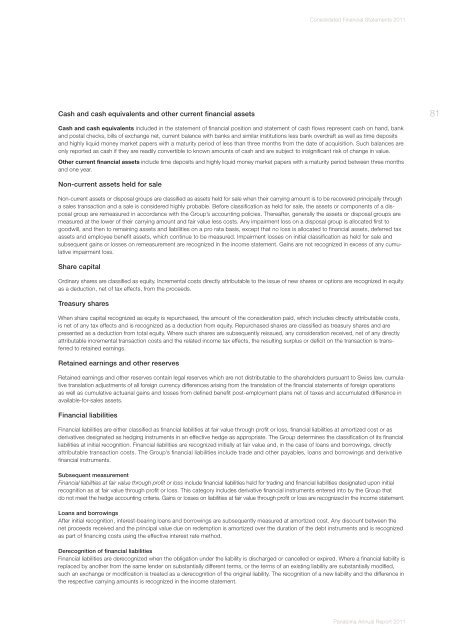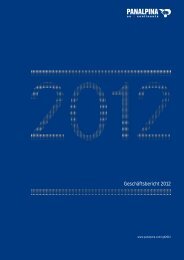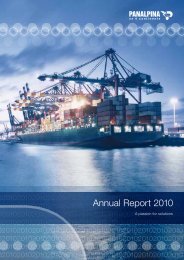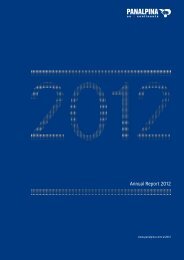Panalpina Annual Report 2011
Panalpina Annual Report 2011
Panalpina Annual Report 2011
You also want an ePaper? Increase the reach of your titles
YUMPU automatically turns print PDFs into web optimized ePapers that Google loves.
Cash and cash equivalents and other current financial assets<br />
Consolidated Financial Statements <strong>2011</strong><br />
Cash and cash equivalents included in the statement of financial position and statement of cash flows represent cash on hand, bank<br />
and postal checks, bills of exchange net, current balance with banks and similar institutions less bank overdraft as well as time deposits<br />
and highly liquid money market papers with a maturity period of less than three months from the date of acquisition. Such balances are<br />
only reported as cash if they are readily convertible to known amounts of cash and are subject to insignificant risk of change in value.<br />
Other current financial assets include time deposits and highly liquid money market papers with a maturity period between three months<br />
and one year.<br />
Non-current assets held for sale<br />
Non-current assets or disposal groups are classified as assets held for sale when their carrying amount is to be recovered principally through<br />
a sales transaction and a sale is considered highly probable. Before classification as held for sale, the assets or components of a disposal<br />
group are remeasured in accordance with the Group’s accounting policies. Thereafter, generally the assets or disposal groups are<br />
measured at the lower of their carrying amount and fair value less costs. Any impairment loss on a disposal group is allocated first to<br />
goodwill, and then to remaining assets and liabilities on a pro rata basis, except that no loss is allocated to financial assets, deferred tax<br />
assets and employee benefit assets, which continue to be measured. Impairment losses on initial classification as held for sale and<br />
subsequent gains or losses on remeasurement are recognized in the income statement. Gains are not recognized in excess of any cumulative<br />
impairment loss.<br />
Share capital<br />
Ordinary shares are classified as equity. Incremental costs directly attributable to the issue of new shares or options are recognized in equity<br />
as a deduction, net of tax effects, from the proceeds.<br />
Treasury shares<br />
When share capital recognized as equity is repurchased, the amount of the consideration paid, which includes directly attributable costs,<br />
is net of any tax effects and is recognized as a deduction from equity. Repurchased shares are classified as treasury shares and are<br />
presented as a deduction from total equity. Where such shares are subsequently reissued, any consideration received, net of any directly<br />
attributable incremental transaction costs and the related income tax effects, the resulting surplus or deficit on the transaction is transferred<br />
to retained earnings.<br />
Retained earnings and other reserves<br />
Retained earnings and other reserves contain legal reserves which are not distributable to the shareholders pursuant to Swiss law, cumulative<br />
translation adjustments of all foreign currency differences arising from the translation of the financial statements of foreign operations<br />
as well as cumulative actuarial gains and losses from defined benefit post-employment plans net of taxes and accumulated difference in<br />
available-for-sales assets.<br />
Financial liabilities<br />
Financial liabilities are either classified as financial liabilities at fair value through profit or loss, financial liabilities at amortized cost or as<br />
derivatives designated as hedging instruments in an effective hedge as appropriate. The Group determines the classification of its financial<br />
liabilities at initial recognition. Financial liabilities are recognized initially at fair value and, in the case of loans and borrowings, directly<br />
attributable transaction costs. The Group’s financial liabilities include trade and other payables, loans and borrowings and derivative<br />
financial instruments.<br />
Subsequent measurement<br />
Financial liabilities at fair value through profit or loss include financial liabilities held for trading and financial liabilities designated upon initial<br />
recognition as at fair value through profit or loss. This category includes derivative financial instruments entered into by the Group that<br />
do not meet the hedge accounting criteria. Gains or losses on liabilities at fair value through profit or loss are recognized in the income statement.<br />
Loans and borrowings<br />
After initial recognition, interest-bearing loans and borrowings are subsequently measured at amortized cost. Any discount between the<br />
net proceeds received and the principal value due on redemption is amortized over the duration of the debt instruments and is recognized<br />
as part of financing costs using the effective interest rate method.<br />
Derecognition of financial liabilities<br />
Financial liabilities are derecognized when the obligation under the liability is discharged or cancelled or expired. Where a financial liability is<br />
replaced by another from the same lender on substantially different terms, or the terms of an existing liability are substantially modified,<br />
such an exchange or modification is treated as a derecognition of the original liability. The recognition of a new liability and the difference in<br />
the respective carrying amounts is recognized in the income statement.<br />
<strong>Panalpina</strong> <strong>Annual</strong> <strong>Report</strong> <strong>2011</strong><br />
81






